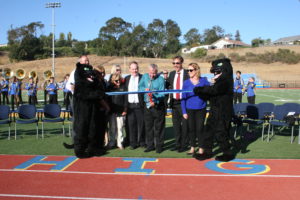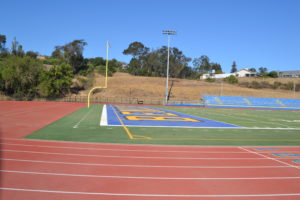
(Left to right) Chief Business Official Tim Rahill (behind panther), school board Trustee Stacy Holguin (also behind panther), Trustee Diane Ferrucci, Measure S Director Roxanne Egan, Trustee Peter Morgan, school board President Gary Wing, Superintendent Charles Young and Benicia High School Principal Brianna Kleinschmidt preside over the ribbon cutting at the grand opening of the newly renovated Drolette Stadium. (Photo by Steve Guertin)
(This post has been updated.)
It is finally here. After more than three years of planning, discussing and numerous construction delays, Benicia High School’s stadium is open for play, following a grand opening ceremony Thursday.
In 2014, Benicia residents voted to approve Measure S, a ballot initiative aimed at providing $49.6 million in bond funding for improvements at Benicia Unified School District’s seven schools. One of the largest projects to be funded by the initiative was the renovation of Benicia High’s George Drolette Stadium, which was constructed around 1966. The renovation of the stadium, which consists of a football and soccer field as well as a track, was expected to be completed in Oct. 2016 but due to various delays— including one of the Bay Area’s rainiest winter seasons in years— the construction kept getting pushed back. Now the field is ready for play, and the school celebrated with a ribbon cutting Thursday.
The stadium boasts a number of new features including aluminum bleachers that can seat up to 3,300 people, an 8-lane all-weather track, upgraded lighting, a new concession stand relocated to the front of the stadium, a “memory brick” circle emblazoned with the names of past and present Benicia High Schoolers, and a new entryway with signage welcoming Panthers. The only element remaining from the previous stadium is the scoreboard.
The ceremony was well-attended, featuring students, staff, parents, the BHS Panther Band, members of the BUSD Governing Board, Benicia High’s football team, Councilmember Mark Hughes, Police Chief Erik Upson, former Citizen’s Bond Oversight Committee Chair Ellen Blaufarb, former Superintendent Janice Adams and Michele Drolette, the daughter of the stadium’s namesake.
In his welcoming remarks, Superintendent Dr. Charles Young thanked everybody for showing up.
“You being here clearly demonstrates your dedication, partnership, interest and commitment to providing our best facilities possible for our very deserving students,” he said.
Young also praised the community’s efforts to make the construction of the stadium possible.
“The scope of this project was significant, involving the thoughtful input of many people,” he said.
Young highlighted the work of the school board trustees who “helped shepherd this project to its completion” and asked the right questions along the way.
“The Bond Oversight Committee also played a key role, making sure we were staying on track and spending bond dollars as we said that we would,” he said.
Young also thanked the community for their patience and expressed enthusiasm about other bond projects to come.
“We have more great projects in the works,” he said. “We look forward to more dedication ceremonies and our ongoing partnership with the citizens of Benicia.”
The next to speak was school board President Gary Wing, who used to volunteer to help with lighting and sound at the previous stadium.
“I started coming to football games 11 years ago,” he said. “At that time, people were saying, ‘We need a new football field.’ I have seen people fall in the old stands, I questioned the stability of the old stands and when we actually got a structural report, the engineer said, ‘You have maybe one more year.’ That was a year ago, so I’m glad that one’s all done.”
Wing said he enjoyed watching the progress of the new stadium and looks forward to future athletic opportunities.
The opening was a sentimental moment for Chief Business Official Tim Rahill who had George Drolette as a physical education teacher in the ‘80s— and his parents had the longtime coach, educator and administrator as a teacher at the school’s old L Street location in the ‘50s. Rahill went on to thank other people who helped make the construction possible, including the voters who approved Measure S, contractor Robert A. Bothman Construction, architect Verde Design, Bond Director Roxanne Egan, Adams, the Citizens’ Bond Oversight Committee and the Parent Teacher Student Association. He also thanked former school board trustees Steve Messina, Andre Stewart and the late Rosie Switzer who were serving when Measure S was discussed and later approved.
“They led the effort to ask the community for $50 million to build this stadium and a whole bunch of other stuff in our district,” he said.
Rahill was not the only alum to give remarks. Principal Brianna Kleinschmidt, a 1997 graduate who used to play soccer on the field, closed out the remarks.
“There’s days like today where words just don’t really explain how exciting it is, how proud I am to be an alumni and be your principal,” she said.
Kleinschmidt considered the stadium to be another positive step in the modernization of the campus in the last couple of years.
“It looks better and better every year,” she said. “It’s exciting to come to school.”
Kleinschmidt also noted the sacrifices that the class of 2017 had to make in the previous year while the stadium was under construction, including holding graduation at Diablo Valley College and the Panthers playing all their games on the road. She also said the new field would be great not only for athletes but also P.E. classes.
“Our football, soccer, and track and field teams will now have the opportunity to learn, develop and compete on a field that is safe and at a competitive level with the other high schools in our area,” she said. “We have a stadium to be proud of.”
“We look forward to cheering on all of our athletes from the sidelines,” she added.
Kleinschmidt joined district officials in the cutting of the ribbon. The next day, the Panthers played their first home game in two years where they defeated Armijo High School 30 to 6.







Can the public use the track to run on?
I believe they’re still discussing that:
http://beniciaheraldonline.com/measure-s-director-finishing-touches-being-put-on-benicia-high-stadium/
Thank you for the link. It would be so nice for those of us who paid for these school bond taxes to use it.